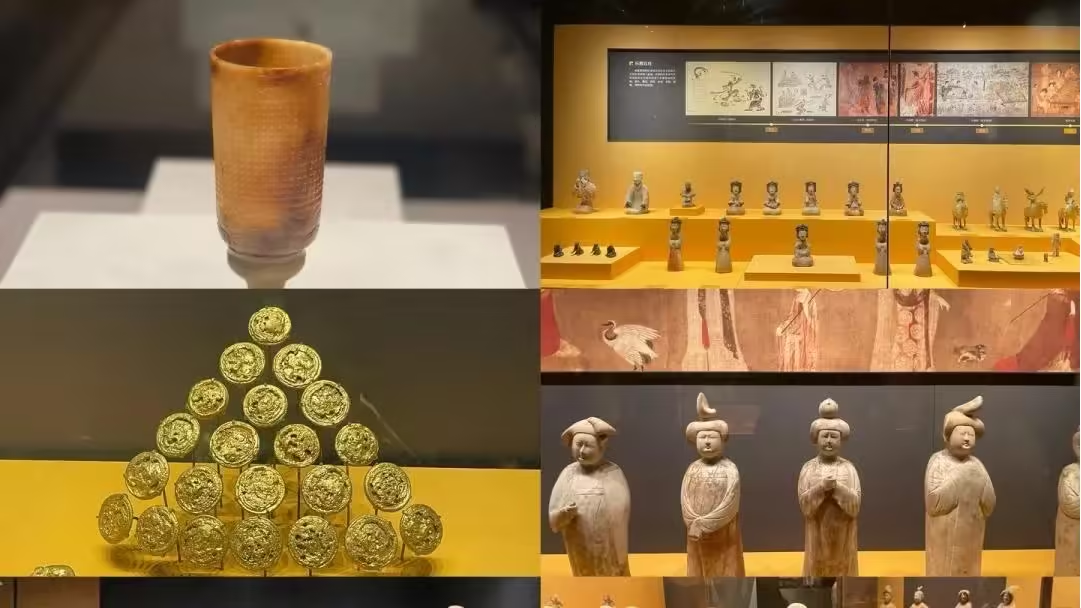Located within the Xiaoyanta Scenic Area, Xi’an Museum is a hidden gem that is less crowded than other major museums in the region, offering a more relaxed and immersive experience. With easy reservations and an impressive collection of relics, this museum is a must-visit for history enthusiasts. From ancient bronze vessels to exquisite jade treasures, let’s explore the iconic exhibits that showcase the rich cultural heritage of Xi’an and its surrounding regions.
Yongyu (Bronze Vessel): Originally a container for water, the Yongyu was also used to hold ice and food in certain contexts. It is an important standard vessel from the period of the Western Zhou Dynasty, with many inscriptions and intricate decorations along its surface. The vessel features a beast-head decoration, and from its long trunk, we can deduce that it represents an elephant, indicating that elephants existed in China as early as 3,000 years ago during the Western Zhou period.
Jade Cup with Linked Cloud Patterns: A star exhibit! This magnificent jade cup is crafted from high-quality caramel-colored jade. It is large in size and meticulously designed, adorned with a variety of patterns, making it a rare and exceptional piece of jadeware. Historically, it has been considered a prime example of Qin Dynasty jade craftsmanship and is said to have been used to hold dew, thanks to its exquisite artistry.
Gold Cake: Shimmering with golden light, this piece is displayed alongside other golden treasures like the hoof-shaped gold and qilin-shaped gold. Together, they create a dazzling golden display within the museum.
Nine Tripod Cauldrons from the Xinmang Period: After Wang Mang became regent, he implemented a series of reforms to strengthen his rule. In terms of ritual reform, he followed the Zhou Dynasty’s customs. The Nine Tripod Cauldrons unearthed include five bronze cauldrons and four glazed ceramic ones, offering a glimpse into the ceremonial practices of the time.

Gilded Sheep Lamp: This charming artifact is a gilded bronze lamp shaped like a sheep. The lamp’s head features a movable knob, and by pulling it, the lamp transforms, with the sheep’s back flipping open to reveal a lamp tray. Despite being over 2,000 years old, the lamp still operates smoothly, showcasing excellent craftsmanship.
Tang Dynasty Female Figurines: This set includes 16 figurines of female attendants, each around 80 cm tall. Originally painted with colorful designs, most of the paint has now faded. The figurines are full-bodied, with diverse hairstyles, expressions, and poses. Notably, one figurine depicts a woman in male clothing, and another represents a camel-riding traveler resting along the Silk Road, offering a distinctive glimpse into the era.
Tang Dynasty Tricolor Hu People Riding a Horse: This dynamic sculpture depicts a robust young man from the Western Regions skillfully riding a horse. The energy captured in this piece is remarkable, with the horse’s four hooves airborne—an uncommon feature in Tang Dynasty art, where horses are typically depicted in static poses. This suggests that the artisans of the time were willing to break away from traditional symmetry to create a sense of movement.
Stone Coffin from the Shijun Tomb: The stone coffin is modeled after a traditional Chinese temple structure with a hip roof. Its four sides are intricately carved with scenes depicting four-armed guardian deities, Zoroastrian gods, hunting, feasting, travel, merchant caravans, sacrificial rites, and ascension to the heavens. Eleven reliefs tell the story of Shijun’s birth, growth, daily life, death, and the ascent of his soul to the afterlife.

